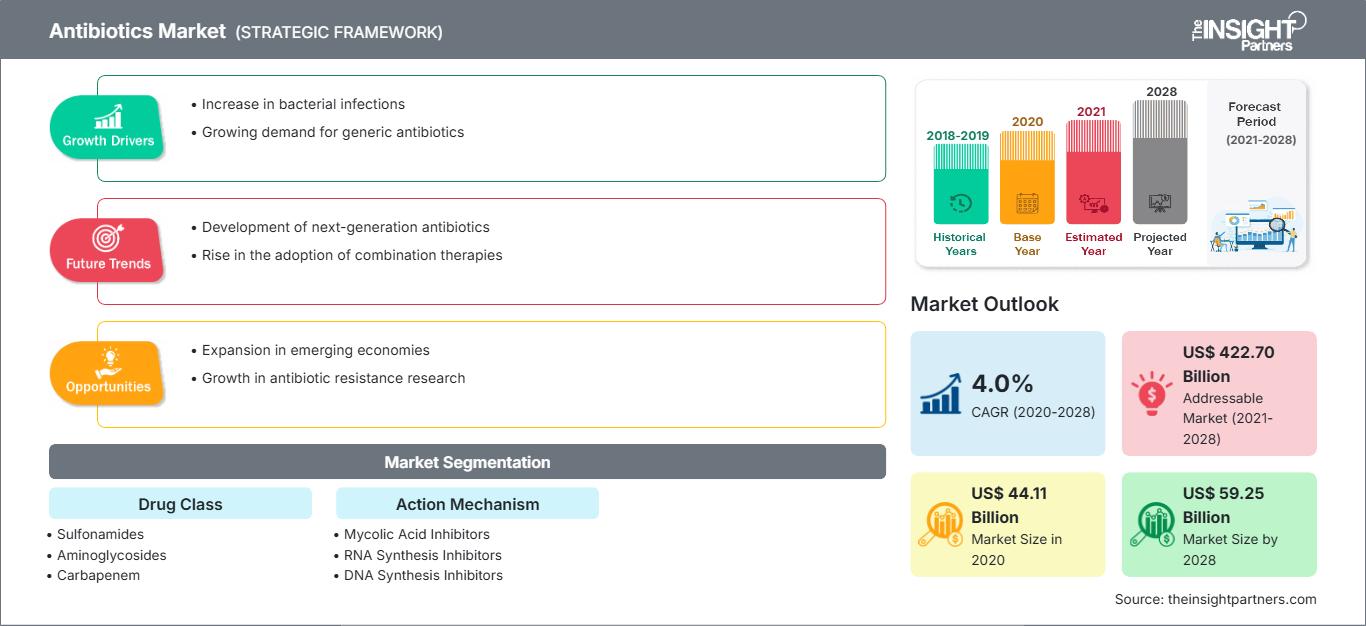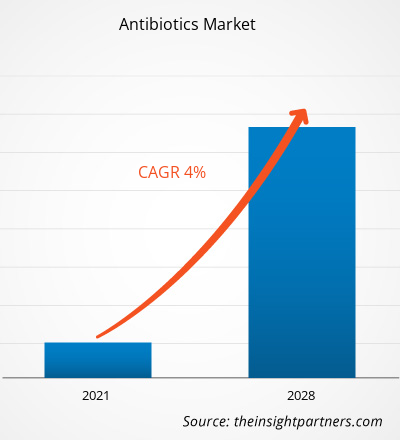Il mercato degli antibiotici è stato valutato a 44.111,31 milioni di dollari nel 2020 e si prevede che raggiungerà i 59.253,24 milioni di dollari nel 2028; si prevede una crescita a un CAGR del 4,0% tra il 2021 e il 2028.
Gli antibiotici sono potenti farmaci utilizzati per combattere infezioni e malattie batteriche. Sono specificamente utilizzati per trattare infezioni causate da batteri come Stafilococco, Streptococco o Escherichia coli. Gli antibiotici uccidono i batteri (azione battericida) o ne impediscono la riproduzione e la crescita (azione batteriostatica). Il mercato degli antibiotici non è efficace contro le infezioni virali. Alcune delle infezioni più comuni trattate con antibiotici sono congiuntivite, infezioni della pelle o dei tessuti molli, infezioni delle vie respiratorie superiori, bronchite, faringite streptococcica (mal di gola) e altre.
Approfondimenti di mercato: crescente sviluppo di farmaci generici
Un farmaco generico è una copia di un farmaco di marca non più coperto da brevetto. Le versioni generiche vengono introdotte sul mercato con l'obiettivo di offrire farmaci convenienti e di aumentarne la diffusione tra persone appartenenti a diverse classi economiche. Le versioni generiche sono popolari grazie alla loro disponibilità e convenienza. Ad esempio, secondo uno studio pubblicato sull'NCBI nel 2018, il prezzo medio di un farmaco di marca con prescrizione medica era quasi 4 volte superiore al prezzo medio di un farmaco generico. Inoltre, le aziende si stanno concentrando anche sullo sviluppo di versioni generiche con l'obiettivo di offrire antibiotici a costi minimi. Ad esempio, nel giugno 2018, Lupin ha lanciato sul mercato statunitense la soluzione inalatoria generica di tobramicina. Inoltre, si prevede che l'incoraggiamento da parte delle autorità governative stimolerà la produzione di antibiotici generici, che a sua volta alimenterà la crescita del mercato degli antibiotici durante il periodo di previsione. Ad esempio, nel febbraio 2019, la Food and Drug Administration (FDA) statunitense ha annunciato l'approvazione per la commercializzazione negli Stati Uniti di medicinali generici prodotti da aziende farmaceutiche indiane.
Potrai personalizzare gratuitamente qualsiasi rapporto, comprese parti di questo rapporto, o analisi a livello di paese, pacchetto dati Excel, oltre a usufruire di grandi offerte e sconti per start-up e università
Mercato degli antibiotici: Approfondimenti strategici

- Ottieni le principali tendenze chiave del mercato di questo rapporto.Questo campione GRATUITO includerà l'analisi dei dati, che vanno dalle tendenze di mercato alle stime e alle previsioni.
In base alla classe di farmaci, il mercato degli antibiotici è segmentato in sulfonamidi, aminoglicosidi, carbapenemi, macrolidi, fluorochinoloni, penicillina, cefalosporine e altri. Il segmento delle cefalosporine ha detenuto la quota di mercato maggiore nel 2020; mentre si prevede che il segmento dei fluorochinoloni registrerà il CAGR più elevato sul mercato durante il periodo di previsione.
Approfondimenti sul meccanismo d'azione
In base al meccanismo d'azione, il mercato degli antibiotici è stato segmentato in inibitori dell'acido micolico, inibitori della sintesi di RNA, inibitori della sintesi di DNA, inibitori della sintesi proteica e inibitori della sintesi della parete cellulare. Il segmento degli inibitori della sintesi della parete cellulare ha detenuto la quota di mercato maggiore nel 2020, mentre si stima che il segmento degli inibitori della sintesi del DNA registrerà il CAGR più elevato nel mercato durante il periodo di previsione.
Le aziende adottano comunemente strategie di lancio e approvazione di prodotti per espandere la propria presenza e il proprio portafoglio prodotti a livello mondiale e soddisfare la crescente domanda.
Gli operatori del mercato degli antibiotici adottano la strategia di espansione per ampliare la base clienti in tutto il mondo, il che consente loro anche di mantenere il proprio marchio a livello globale. Ad esempio, nel luglio 2019, aziende come Pfizer hanno lanciato un consorzio di ricerca internazionale per scoprire e sviluppare nuovi antibiotici contro la tubercolosi in collaborazione con otto partner biotecnologici e accademici europei.
Approfondimenti regionali sul mercato degli antibiotici
Le tendenze regionali e i fattori che influenzano il mercato degli antibiotici durante il periodo di previsione sono stati ampiamente spiegati dagli analisti di The Insight Partners. Questa sezione illustra anche i segmenti e la geografia del mercato degli antibiotici in Nord America, Europa, Asia-Pacifico, Medio Oriente e Africa, America Meridionale e Centrale.
Ambito del rapporto sul mercato degli antibiotici
| Attributo del rapporto | Dettagli |
|---|---|
| Dimensioni del mercato in 2020 | US$ 44.11 Billion |
| Dimensioni del mercato per 2028 | US$ 59.25 Billion |
| CAGR globale (2020 - 2028) | 4.0% |
| Dati storici | 2018-2019 |
| Periodo di previsione | 2021-2028 |
| Segmenti coperti |
By Classe di farmaci
|
| Regioni e paesi coperti | Nord America
|
| Leader di mercato e profili aziendali chiave |
|
Densità degli operatori del mercato degli antibiotici: comprendere il suo impatto sulle dinamiche aziendali
Il mercato degli antibiotici è in rapida crescita, trainato dalla crescente domanda da parte degli utenti finali, dovuta a fattori quali l'evoluzione delle preferenze dei consumatori, i progressi tecnologici e una maggiore consapevolezza dei benefici del prodotto. Con l'aumento della domanda, le aziende stanno ampliando la propria offerta, innovando per soddisfare le esigenze dei consumatori e sfruttando le tendenze emergenti, alimentando ulteriormente la crescita del mercato.

- Ottieni il Mercato degli antibiotici Panoramica dei principali attori chiave
- Cefalosporina
- Penicillina
- Fluorochinoloni
- Macrolidi
- Carbapenemi
- Aminoglicosidi
- Sulfonamidi
- Altri
Mercato globale degli antibiotici: per meccanismo d'azione
- Inibitori della sintesi della parete cellulare
- Inibitori della sintesi proteica
- Inibitori della sintesi del DNA
- Inibitori della sintesi dell'RNA
- Inibitori dell'acido micolico
- Altri
Antibiotici globali: per meccanismo d'azione Per area geografica
Nord America
- Stati Uniti
- Canada
- Messico
Europa
- Francia
- Germania
- Italia
- Regno Unito
- Spagna
- Resto d'Europa
Asia Pacifico (APAC)
- Cina
- India
- Corea del Sud
- Giappone
- Australia
- Resto dell'Asia Pacifico
Medio Oriente e Africa (MEA)
- Sudafrica
- Arabia Saudita
- Emirati Arabi Uniti
- Resto del Medio Oriente e Africa
Sud America
- Brasile
- Argentina
- Resto del Sud America
Profili aziendali
- Pfizer, Inc
- Johnson & Johnson Services, Inc. (Janssen Pharmaceuticals),
- Abbott,
- GlaxoSmithKline Plc,
- Sanofi,
- Novartis AG,
- Bayer AG,
- Bristol Myers Squibb Company,
- Eli Lilly and Company,
- Astellas Pharma
- Analisi storica (2 anni), anno base, previsione (7 anni) con CAGR
- Analisi PEST e SWOT
- Valore/volume delle dimensioni del mercato - Globale, Regionale, Nazionale
- Industria e panorama competitivo
- Set di dati Excel
Report recenti
Rapporti correlati
Testimonianze
Motivo dell'acquisto
- Processo decisionale informato
- Comprensione delle dinamiche di mercato
- Analisi competitiva
- Analisi dei clienti
- Previsioni di mercato
- Mitigazione del rischio
- Pianificazione strategica
- Giustificazione degli investimenti
- Identificazione dei mercati emergenti
- Miglioramento delle strategie di marketing
- Aumento dell'efficienza operativa
- Allineamento alle tendenze normative




















 Ottieni un campione gratuito per - Mercato degli antibiotici
Ottieni un campione gratuito per - Mercato degli antibiotici